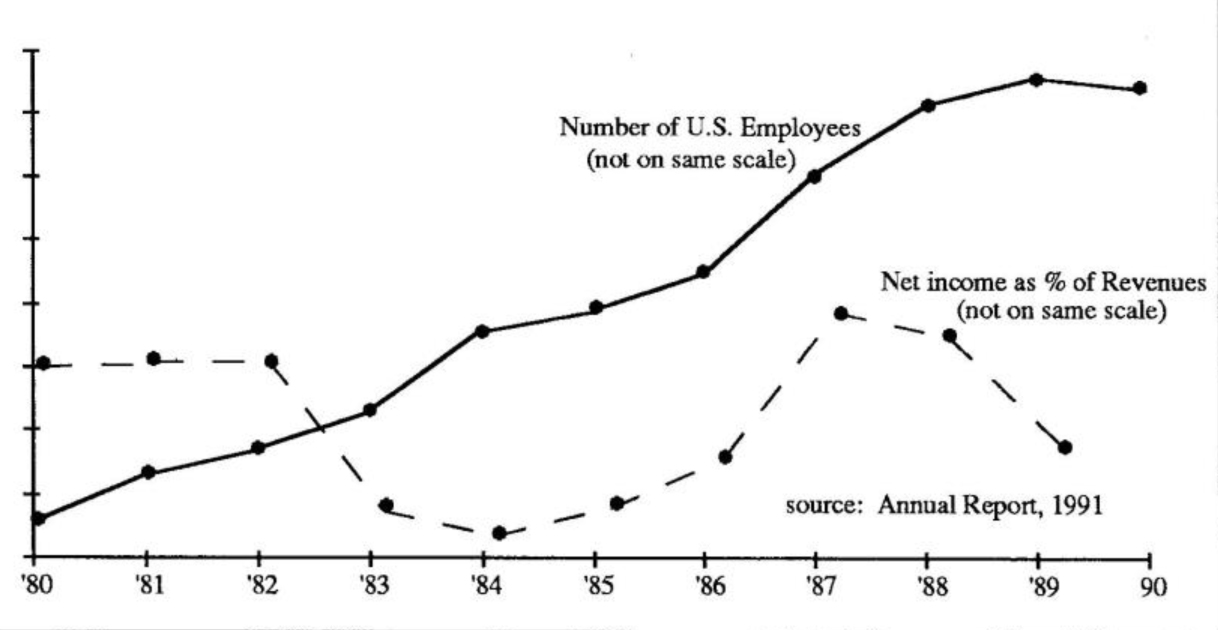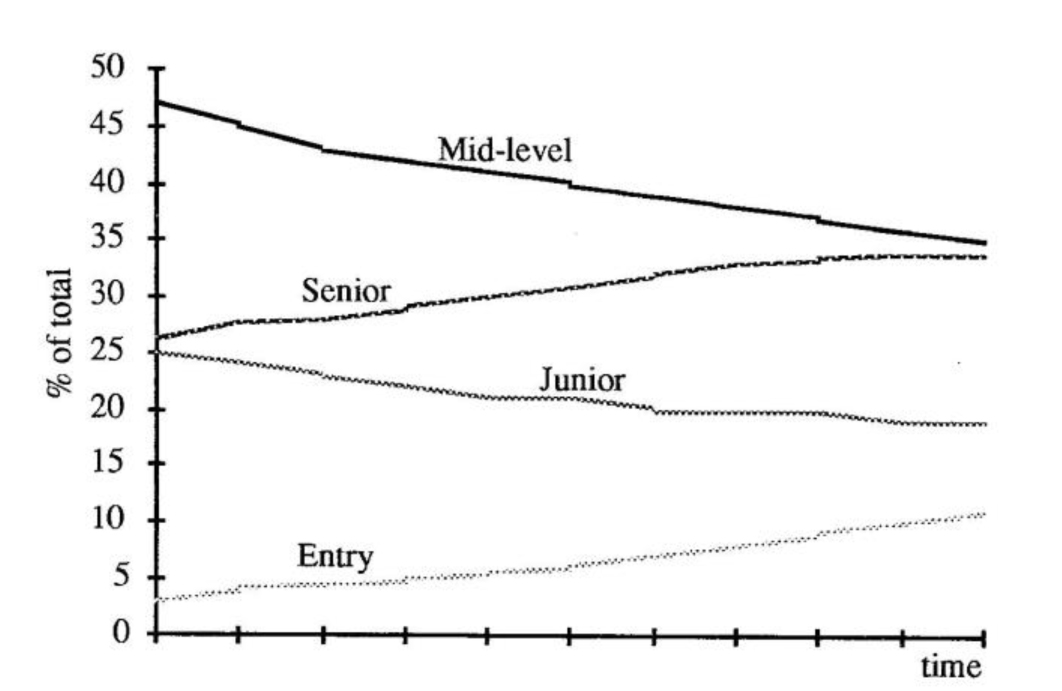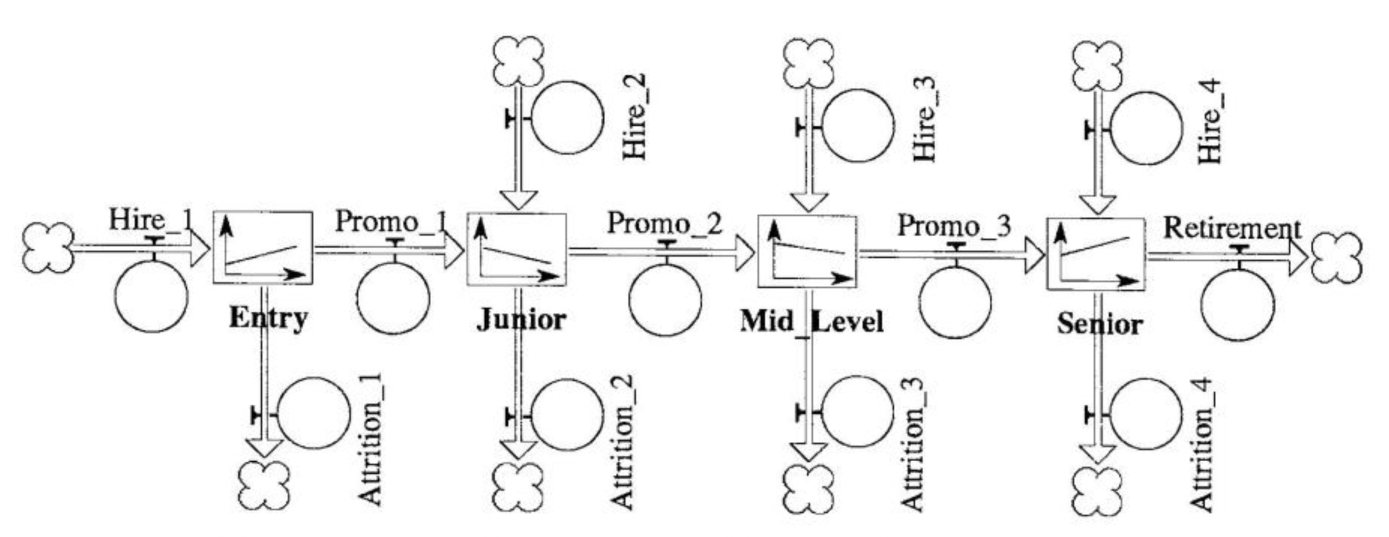In 1989, Digital Equipment Corporation in the United States faced business conditions unique in its 30-year history. Historically, Digital had been a high-growth company in a high-growth industry. To keep up with the rapid growth, Digital hired a large number of people between 1983 and 1987 (sec “Workforce and Revenue Trends” graph). The large number of new hires, as well as Digital’s traditionally low turnover, allowed the workforce to keep up with the rapid pace of change in the industry.
But a sluggish U.S. economy had resulted in a slowdown in information systems spending, Digital’s marketplace. At the same time, the emergence of Open Computer systems and desktop computing threatened Digital’s mainstream revenue source, its proprietary operating system. As new product lifecycles in the computer industry shrank, customers became more likely to hold off on upgrades or purchases until the next generation of hardware emerged.
These conditions meant unique challenges for Digital’s workforce planning team. They needed to not only shrink Digital’s high cost structure, but also position the workforce to take advantage of new areas emerging in the industry. In addition, Digital’s evolving business mix — towards systems integration, solution selling, and customization — meant new skill requirements for the workforce.
Digital had entered a new business arena, but its workforce was not well-positioned to meet the demands of the marketplace. The challenge was to reexamine the distribution as well as the flow of people within the different business functions, and to match people with the appropriate skills to emerging business areas.
Workforce and Revenue Trends

There were many different opinions about Digital’s workforce challenges. Many people felt that the downturn was temporary and not indicative of any fundamental trend. Their belief was that Digital would “outgrow” the revenue slowdown, as it had in the past. Some felt the only solution was dramatic downsizing across the board, to bring expenses more in line with revenues. Still others, again believing the problem was an oversized workforce, were advocating less dramatic actions such as a hiring freeze or a moderate workforce cut. The multitude of perceptions within the company indicated that there was no consensus on the issues involved, the alternatives, or the long-term impact of various workforce policies.
To address these issues, our internal consultants, along with the new U.S. Workforce and Organizational Planning Manager, applied a systems thinking approach to better understand the workforce planning challenges that faced Digital.
The key questions we addressed were:
- How can we categorize our workforce in order to gain a more meaningful look at the underlying dynamics within and across all functions?
- What would be the impact on our workforce capability and corporate profitability if we implemented each of the following policies: continue with “business as usual,” maintain current headcount, or implement across-the-board cuts?
- What are the important factors we need to consider when planning for future workforce needs?
(Editor’s note: Readers may want to try their hand at answering the above questions and perhaps identify analogous “accumulator management” challenges in their own organizations”)
The Digital U.S. Professional Workforce Planning Project was initiated to explore key issues of workforce allocation as they related to Digital’s high cost structure and evolving business mix. The challenge was to find a set of human resource policies that would allow Digital to maintain a workforce that was flexible and adaptable to the current and future business environment.
We began by making what we called an “intelligent categorization” of our U.S. professional workforce — an inventory of our employees by function and by level. Within each product or service function, we divided the workforce into four levels according to skills: entry level, junior level, midlevel individual contributor/first line manager, and senior individual contributor/senior manager (an individual contributor is someone who could have the same level of responsibility as a manager, but does not supervise other employees). We realized, however, that the categorization was only the first step. Our inventory gave us no idea of the movement of people throughout the organization, or the effects of human resource policies on their movement.
From the initial categorization, we created a computer simulation model (using STELLA modeling software) that would allow us to gain insight into the flow of people between functions and between skill levels within functions. The model was very “primitive” in the sense that we tried to build the simplest model that would capture the relative dynamics. For each function, we looked at the different skill levels as accumulators. The major policies that determined the flows into and out of the accumulators were hiring, promotion, and attrition rates (see “Workforce Planning Model Overview” diagram).
Once we felt the model captured the relevant dynamics, we began to explore the long-term impacts of various policies.
Status Quo Scenario
The first scenario we looked at was the status quo policy: what would happen in five years if we continued our current year’s hiring, promotion, and attrition policies? This meant little hiring except in critical areas, and following a very conservative growth strategy. The status quo scenario tested the perception held by some managers that our current strategy of managing the total headcount, without attention to the mix between different levels, would be effective for the long term.
Status Quo Policy

The resulting picture was clearly not where we wanted to be in five years. Although total headcount remained fairly steady, a look at the number of employees between different levels revealed a large mix imbalance (see “Status Quo Policy” graph). The mid- and junior-level headcount decreased, while the entry and senior levels swelled. The simulation revealed that the status quo policy, designed to control costs, would actually raise our cost structure because of the increase in higher-salaried employees. Even a very conservative estimate of the resulting costs showed a large impact on Digital’s profitability.
In addition, the mix imbalance would have a tremendous effect on the skills and responsibilities of the workforce. If we did not implement dramatic changes that were consistent with the new workforce mix (such as an expansion of responsibilities in the senior and entry levels), the result would be an underutilized workforce at the senior level and an overtaxed workforce at the junior level.
Equilibrium Scenario
The second strategy we tested was “what would it take to keep the total headcount and mix balance the same in five years as it is today?” The assumption behind this scenario was that what we have now in terms of a workforce mix is adequate for our future needs.
In order to simulate this scenario, we identified areas in the company that are growth areas and built in a modest growth trend. In addition, we maintained or flattened areas that are not critical business units. In this way, the total headcount across Digital U.S. and the headcount within each skill level would stay the same, but the headcount between different functions would vary. The growth in key areas would bring in more revenues, which would shrink the current discrepancy between our cost structure and revenue stream.
Again, the simulation showed surprising results. In order to maintain our current headcount and skill mix, we would have to make dramatic changes in attrition and hiring policies across the company. Pursuing this strategy would require a lot of intervention in the system, something that most managers are reluctant to do.
Workforce Planning Model Overview

A structural diagram of the workforce planning model captures the movement of employees through different seniority levels within a function. The flows of employees are determined by hiring, promotion, and attrition policies.
Across-the-Board Cuts
Another scenario we looked at was the effect of across-the-board policies on the headcount and skill level mix in various functions. Many managers have expressed the opinion that the solution to our current difficulties is to execute dramatic or moderate cuts across all functions. While this policy would generate immediate costs savings, we wanted to gauge the effects of such action over time.
The results of the simulation were similar to the “status quo” scenario. There was a wide variance in the resulting skills mix across different functions, which suggested that managing total headcount alone was not a viable long-term option. We need to look at other dimensions, such as the skills mix within functions, in order to maintain a flexible, productive workforce.
Our conclusion from this scenario was that different functions have different workforce dynamics, and the policies we pursue need to be sensitive to those differences and the different growth rates in those functions. For example, our computer systems are more reliable than they were 10 years ago, so we don’t need to allocate as many engineers to our repair function. At the same time, the emerging area of systems integration requires a more mature workforce with different abilities, such as project management and consulting skills, so we need to target a different workforce population for that function.
Rethinking Future Planning
The results of the various scenarios stimulated some insights that will help us rethink our criteria for future workforce planning:
- We cannot simply implement a blanket policy across all functions. A knee-jerk reaction to increased demand or revenue shortfalls — cutting or adding staff across all functions — doesn’t take into account the different dynamics that are operating within each function. A reduction that increases efficiency in one area could rob an emerging area of the vital resources it needs to grow.
- Managing total headcount is not the answer. Total headcount is one of the easiest parameters to measure and control. But “management by headcount” excludes other vital issues in workforce planning, such as maintaining an appropriate skills mix within and across different functions.
- Hiring at junior level must continue. Even when trying to maintain current employee levels, it is important to keep hiring at the junior levels. This action prevents a “top-heavy” workforce, and injects new skills into the organization.
- Changing promotion policies is key to creating a more flexible workforce. A flexible workforce that can respond quickly to emerging new areas is crucial in a fast-evolving industry such as computers. One way to gain a more flexible workforce is to create more lateral career paths, which will allow employees to gain more experience and responsibility without changing the mix of levels in the company. Modifying promotional policies is a high-leverage action for managing the flow of people and the mix of skills throughout the organization.
Planning Future Needs
The simulation model and the insights it has generated are now being shared with the U.S. Human Resource Management community. Our primary goal in the next phase of the project is to provide a systems framework for understanding the underlying causes of our revenue slowdown as it relates to workforce management, and to stimulate a rethinking of what constitutes high-leverage actions for planning our future workforce needs.
Naila Seif is an internal management consultant at Digital Equipment Corporation who has worked on projects ranging from sales and marketing to product development. She and Internal Consultant Rob Greenly provided the primary consulting support on this project.
